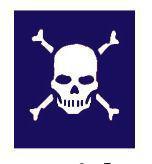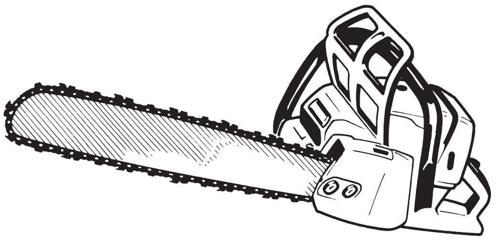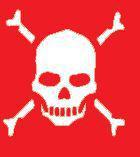SAS Urban Survival Handbook (32 page)
Read SAS Urban Survival Handbook Online
Authors: John Wiseman
Tags: #Health & Fitness, #Reference, #Survival, #Fiction, #Safety, #Self-Help, #Personal & Practical Guides, #General, #Survival Skills

There may be specific dangers from some woods. African boxwood in your system can cause you to feel tired and lose the ability to concentrate – which could be very dangerous if operating machinery.
Wood oils and sap may be poisonous. Further hazards arise if the wood being worked on has been treated with preservatives, fungicides, insecticides, waxes, oils, polishes, glues, shellac and varnishes. Even new timber may have been treated with the first three at the timber yard.
Fungicides, for example, may be very toxic and have been linked – in addition – to anaemia and disorders of the central nervous system and liver.
Heating of the wood while working may be a factor – sanding, sawing and planing all generate heat, which may alter the chemical nature of wood dust or treatments that have been used on the wood.
Ventilation and dust extraction are VITAL. Breathing protection should NOT be taken lightly, nor should eye protection, barrier cream and – when possible – gloves. Always wash or shower well after exposure. Avoid dry sweeping or using a vacuum cleaner, unless the latter is specially designed for the job or the exhaust of a domestic model is not venting back into the work area. Small particles travel straight through domestic vacuum cleaners. Damp down dust or use a damp mop instead.
Avoid any dust from (most) plywoods, chipboards, blackboards and particle boards. The resin/glue used to hold them together may release FORMALDEHYDE – associated with headaches, ‘persistent’ colds and coughs, asthma, depression, insomnia, dermatitis, and possible links with cancers.
Nearly all woods have thus far been identified as requiring caution. The amount of exposure required to cause some of the more serious effects is not clear. It should therefore be considered that there is no ‘safe’ exposure level for inhalation. Even the most common woods (as the following, by no means definitive, list shows) are known to have caused health problems.
Beech, birch, African boxwood, South American boxwood, red cedar, dogwood, ebony, greenheart, African mahogany, American mahogany, maple, obeche, pine, ramin, redwood, Brazilian rosewood, Indian rosewood, satin wood, teak
Because of the devastation of tropical forests, more and more ‘exotic woods’ are becoming readily available. Treat all with caution.
Fire/explosion risks should also always be considered with the presence of dense wood dust. It is very unwise to smoke, have naked flames or create a lot of sparks in a heavily-dusty atmosphere. DON’T take ventilation lightly. It could save your life.
HIRE TOOLS
 The really determined do-it-yourself enthusiast may have occasional need for tools which are too expensive or too specialized to be worth buying and trying to find storage space for. ‘Hire’ shops will offer almost any equipment, from wallpaper strippers to spanners. Apart from the dangers of unfamiliarity with larger tools, there is also the danger that—when hiring by the day or by the hour – you may be tempted to hurry a job.
The really determined do-it-yourself enthusiast may have occasional need for tools which are too expensive or too specialized to be worth buying and trying to find storage space for. ‘Hire’ shops will offer almost any equipment, from wallpaper strippers to spanners. Apart from the dangers of unfamiliarity with larger tools, there is also the danger that—when hiring by the day or by the hour – you may be tempted to hurry a job.
Plan the work and choose the tool very carefully. Try not to work alone. If an accident happens, you may need someone to raise the alarm.
ALL PREVIOUSLY STATED RULES FOR TOOLS APPLY.
When hiring equipment
- ◑ Hire from a reputable dealer.
- ◑ DON’T accept a heavier or more unwieldy machine than you feel you could cope with.
- ◑ CHECK the machine is complete, with all attachments.
- ◑ CHECK to see if special tools are required for making adjustments /fixing attachments.
- ◑ DON’T accept machines which show any signs of slipshod repair work.
- ◑ Be wary of machines which have just been returned—and have not been ‘checked over’.
- ◑ Ask for clear instructions, safety advice AND a demonstration, if necessary.
- ◑ Make sure you have the correct protective gear.
When using equipment
- ◑ Use the equipment exactly as instructed.
- ◑ Use the equipment only for the specific type of job it was intended to do.
- ◑ Don’t over-exert yourself to get the job done quickly, because of the cost of hiring.
- ◑ Stop and check the equipment over for leaks, worn cables or loose connections from time to time.
- ◑ If the equipment sounds ‘unhealthy’ or appears to be having difficulty, STOP. Contact the supplier.
- ◑ Don’t be afraid to contact the supplier if you are the least bit unsure of the performance of the machine. Your safety is far more important than what the person in the shop might think of you.
- ◑ Keep children and animals well away from the equipment—in fact, from the entire work area.
- ◑ Do not leave the equipment unattended for any length of time whatsoever.
CHAINSAWS
 A large petrol-driven chainsaw is possibly one of the most dangerous tools. In inexperienced hands, records prove that all manner of horrific accidents are possible—but accidents can happen to anyone. DON’T work alone. Expect the unexpected. DON’T take chances. Avoid a chainsaw ‘massacre’!
A large petrol-driven chainsaw is possibly one of the most dangerous tools. In inexperienced hands, records prove that all manner of horrific accidents are possible—but accidents can happen to anyone. DON’T work alone. Expect the unexpected. DON’T take chances. Avoid a chainsaw ‘massacre’!

Before you start
Ensure that children and animals are kept well away from the work area. You should have thick, not loose, clothing. Long hair should be tied back. Steel-toe-capped boots are essential, as are thick well-fitting gloves. There are specially made reinforced gloves, which should be safer. There are also limb and torso guards—some are designed to ‘burst’ on impact, fouling the blade and stopping it. These may not be readily available, but are worth investigating.

WARNING
Under no circumstances consider using a chainsaw if you are tired, drunk or feeling ill. If the weather is very blustery or wet, forget it. DON’T work alone.
Further protection
Both you and your assistant should have impact-resistant safety goggles and hearing protectors. Debris could be thrown a considerable distance. Your assistant should be close enough to ‘assist’ but not to get in the way. Try to keep them ‘behind the blade’—where you are.
Using the saw
Before starting the saw, check there is fuel in the tank and oil in the reservoir. If the weather is cold, you may need to use the ‘choke’. Clear the area. Your assistant should stand well away.
When the engine is running, the blade should NOT run at idling speed. If it does—STOP. Consult the supplier, unless you know how to make the adjustment. Check the chain brake. Apply it and open the throttle. The chain should not move. If it does—STOP. This might not be a simple adjustment. Consult the supplier.
Fuel safety
Before refilling the tank, you MUST allow the engine to cool down. It could very easily be hot enough to ignite petrol spilled onto it. Open the cap slowly to release any ‘pressure’. A funnel should help you avoid spilling fuel. DO NOT SMOKE!
After refilling, ensure the cap is tight—vibration while working can loosen the fit and fuel may spill onto you unnoticed. Sparks may come out of the exhaust and ignite the fuel.
Store spare fuel well away from the work area.
When cutting
- ◑ Use the part of the blade nearer the engine, to give you more control. Working close to the tip is tiring, and you are risking KICKBACK (see below).
- ◑ If you are sawing a long horizontal piece of wood, do so from above. Support on either side of the cut line, fairly close to it. If supports are too far apart, the wood will ‘droop’ as the cut is made—closing the cut and gripping the blade. This is extremely dangerous.
- ◑ ALWAYS cut from above—not from below or sideways.

WARNING
KICKBACK: Using the tip of the saw is very dangerous indeed. This is when some of the most serious accidents have happened. It is impossible to control the blade, which may ‘jump away’ from the wood violently. You or your assistant may be seriously injured. The chain may even break and fly off. NEVER work near the tip of the blade. Allow free space around it at all times. DON’T bring the tip down to touch the ground. DON’T attempt to ‘pierce’ with the blade.
Tree felling
It is impossible to give directions for coping with every possible variation of tree work. Accidents are numerous—both from the saw and from heavy branches falling unexpectedly. Tree felling/pruning may look easy and, to some people it seems to be quite exciting—but do NOT attempt it unless you know what you are doing.
SAFETY RULES
- ■
NEVER walk about with the blade moving—or even with the motor running. If you trip, the brake may disengage - ■
DON’T strain when using the saw. DON’T do anything that feels awkward - ■
DON’T cut above your waist height. NEVER at shoulder height. NEVER above your head - ■
DON’T work up a ladder—even on trees. Professional tree cutters know what they’re doing and use harnesses, ropes and winches—they don’t just cut off branches and ‘see what happens’ - ■
DON’T set a hot saw down where a fire could start - ■
DON’T work in a tight space—have room for movement - ■
Plan your ‘escape route’. If an accident happens, you may have to jettison the saw. Keep a space in mind for this, and keep your assistant out of the ‘line of fire’ - ■
Only cut wood with the saw - ■
NEVER cut into the ground - ■
BEWARE of nails in timber! - ■
ALWAYS disconnect the spark-plug lead if attempting to clean or adjust the blade - ■
The saw should do the work. Don’t force it. If you have to use excessive pressure, the blade may be blunt. STOP - ■
Don’t work in amongst brush and twigs which may prevent you using the saw safely—and being able to operate safety devices - ■
The chain should not be loose. If it is—STOP